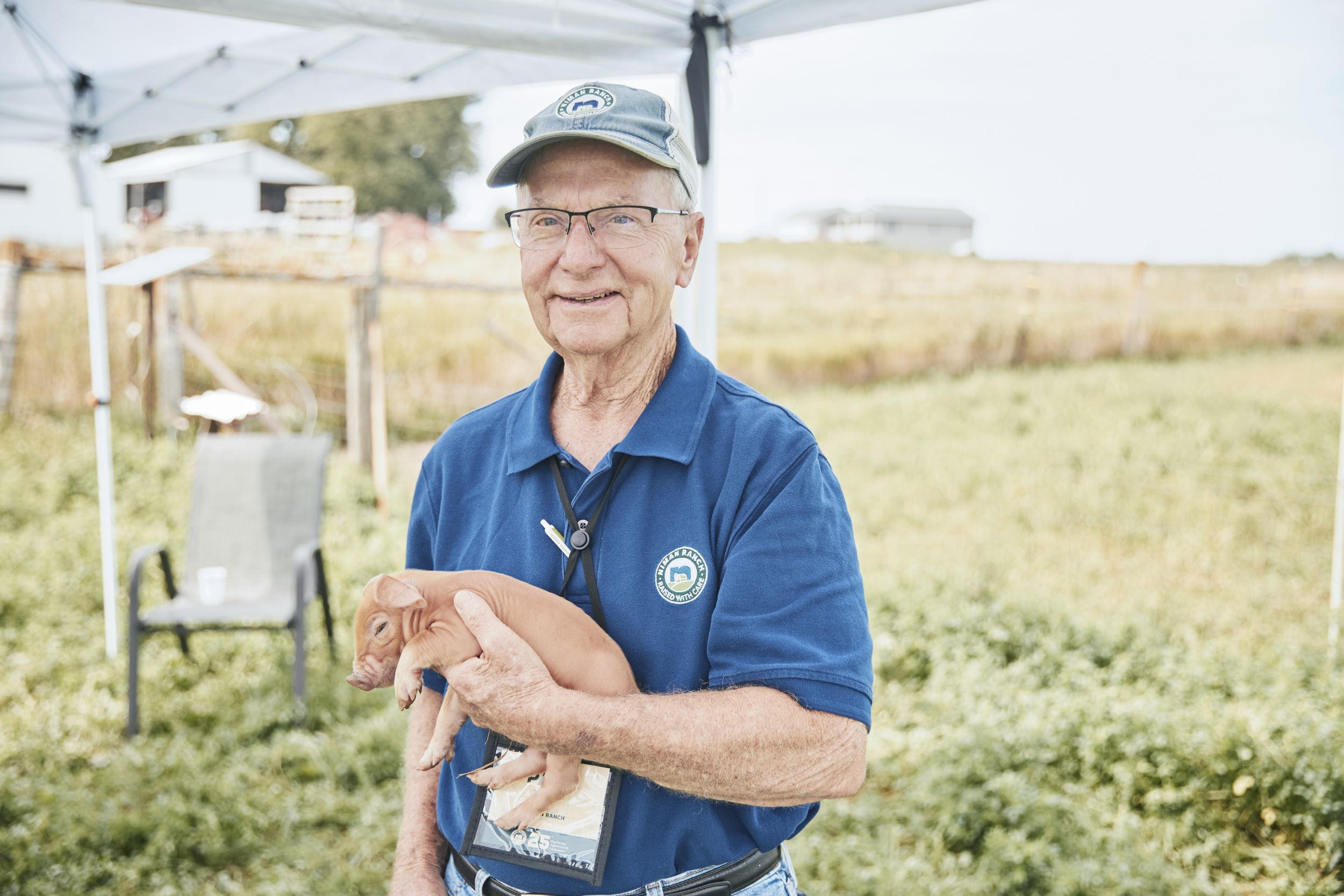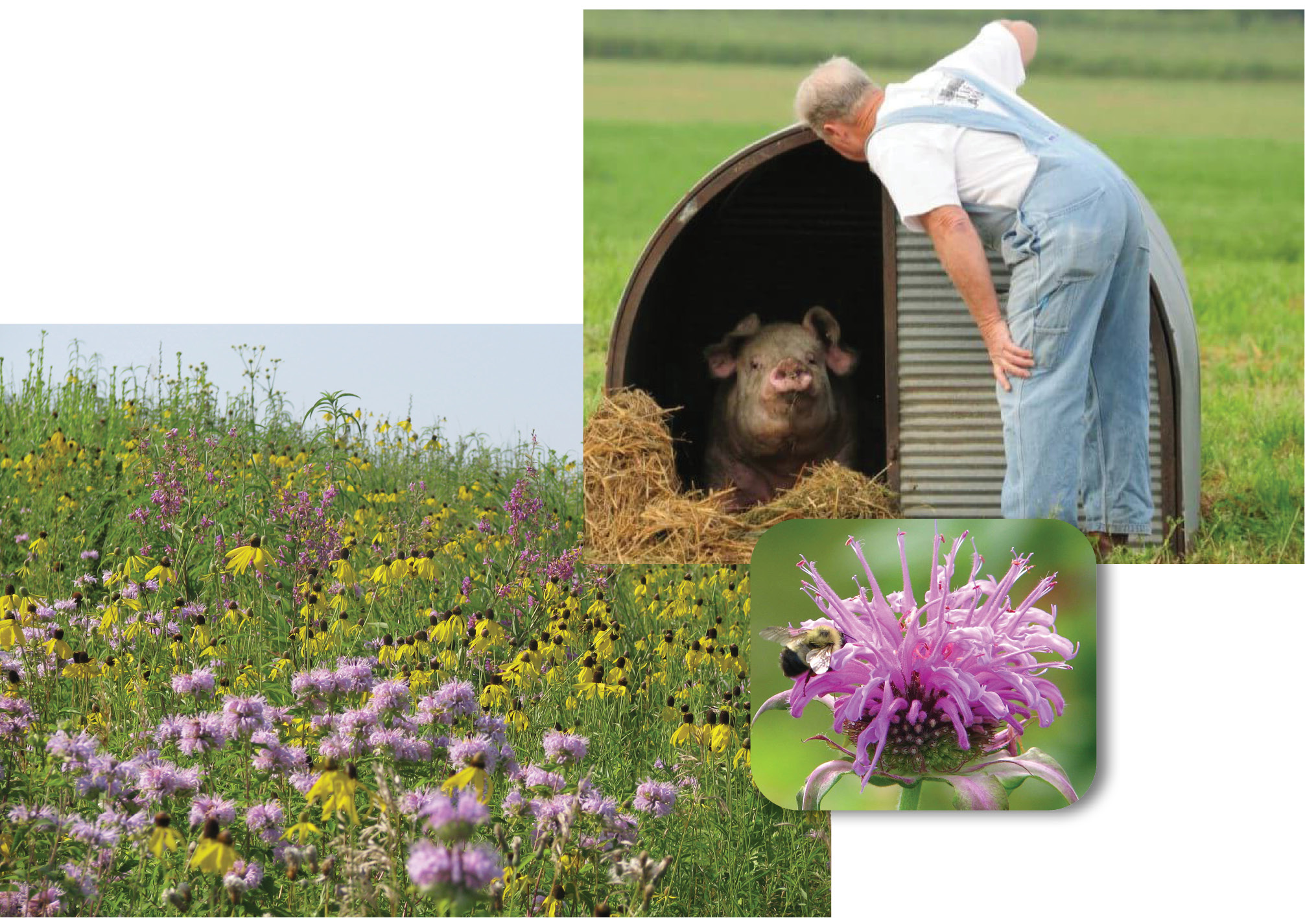Layers of Richness
By Abby Hade Terpestra on May 12, 2025 in Blog
 Paul Willis knows about pigs. But really, what it comes down to is he knows about people. He knows how to build connections and relationships, coalitions and communities. He knows how to connect with and learn from people.
Paul Willis knows about pigs. But really, what it comes down to is he knows about people. He knows how to build connections and relationships, coalitions and communities. He knows how to connect with and learn from people.
Take his friendship with Daryl Kothenbeutel. Daryl ran Iowa Prairie Seed Company and tended what is now known as the Kothenbeutel Heritage Prairie in Franklin County, an important local-ecotype seed source and stunningly diverse 40-acre prairie. Daryl passed the prairie over to INHF’s care in 2005 upon his retirement to ensure the protection and stewardship of that special site, and Paul saw it happen.
“I’ve watched with interest the progress being made to preserve parts of Iowa,” Willis said. “I was influenced by what I saw around me in the Clear Lake area.”
Add some peer pressure from folks like former director of the Drake Agricultural Law Center, Neil Hamilton, to encourage Paul to join him on the INHF board of directors, and voila — you have Paul Willis, founder of Niman Ranch Pork Company (NRPC), being voted in to further the mission of protecting and restoring Iowa’s land, water and wildlife in 2019.
“Serving on INHF’s board gives me the opportunity to go to places that have been preserved — something I think everyone should try to get out to see. It’s eye opening to see the uniqueness of different parts of Iowa.”
Growing up, Willis spent countless hours exploring his grandparents’ crick in Thornton and observing their gardens and bird feeders. “I’ve always been intrigued by birds and any kind of animals,” he said. But as he grew, he noticed changes. The life he remembered in the crick went missing. “It became sterile, reduced in quality and abundance.”
“If I could accomplish one thing,” Willis mused, “it would be to change the water quality in the state of Iowa. It’s a big task but that’s where INHF can help.”
After graduating from the University of Iowa, Willis served in the Peace Corps in Nigeria. “We started our training in California, and I saw how different the vegetation was there. Then I lived in a west African savanna and every plant, every tree was different. It raised my awareness and made me wonder — what was in Iowa before?”

At Paul Willis’s ‘dream farm’ you can find rare bird species like Henslow’s Sparrow and 135 species of flowering plants, like the monarda and gray headed coneflower above.Paul’s standards for raising hogs have set ethical standards for farmers across the United States. Photos courtesy Niman Ranch.
Returning home to Iowa in 1975, Paul followed the family legacy as a fifth-generation farmer. In addition to the standard corn and beans, Paul began raising hogs outdoors on pasture; a method that was going by the wayside as industrial pork producers moved into Iowa.
In his free time, he started walking along railroad tracks and through ditches looking for native species. Plants that he may have seen before but never noticed.
In the ‘80s and ‘90s, Willis saw confinements coming into Iowa and started advocating for a different way of raising hogs, one with high standards for animal welfare and stewardship of the land. In 1994, Willis met with sustainable beef producer Bill Niman, who was part of the growing high food culture scene in California. “I saw free range chicken,” said Willis, “and I wondered, what about free range pork?” Niman was looking for a pork producer that met his high standards, and Paul’s product and ethic fit the bill.
In 1995, Willis made his first specialty sale, supplying pork to Bay area farm-to-table restaurants like Alice Waters’ Chez Panisse.
In 1998, Niman Ranch Pork Company was officially formed. In addition to running his own 700-acre farm, Paul co-wrote the first pork animal welfare certification standards for the ethical raising of hogs in the United States and promoted it to others. He has overseen and inspired the growth of NRPC to a network of 600+ Certified Humane, independent farmers and ranchers across the United States. Today, you can find Niman Ranch products at restaurants and grocers nationwide.
“This method tends to have more diversified farms, and better habitat. The systems are closer by far to what Iowa was than conventional ag is today,” said Willis. “Food systems and INHF are linked together. It’s about the ecosystems on the land. Clean water, a diversity of plants and animals. It’s about more than just one species.”
Paul has made time and space in his own life to live these beliefs beyond the farm.
When the Wetland Reserve Program began, Willis purchased a quarter section of hilly pothole land, rebuilt the wetlands and seeded it in 2002. His friend, Daryl Kothenbeutel, helped inventory over 135 species of forbs.
“It’s been rewarding since the very first day,” said Willis. “We recorded the first nesting Henslow’s Sparrow in the county. I knew we’d succeeded in creating a habitat when I saw a Bald Eagle, Sandhill Crane, and Trumpeter Swan all in one day.”
“We need that balance. Diversity of species in an indicator of health. We’re supposed to have Bobolinks, meadowlarks, sparrows like Henslow’s and Clay.”
Willis still hand collects seeds from wild patches of prairie to interseed his own reconstruction, lovingly called The Dream Farm by his family.
“Instead of having a dream home, we have a dream farm. It’s absolutely spectacular when it is in full bloom. People are moved by experiencing it. We love having folks come see it.”
Asked what inspiration he would share with others, Willis said, “Spend time with people who know what they’re doing. Sure, Aldo Leopold is inspiring. But just try to get to know people who know a lot. You pick up knowledge that way. It’s great to have experts around, it is really interesting and rewarding.”